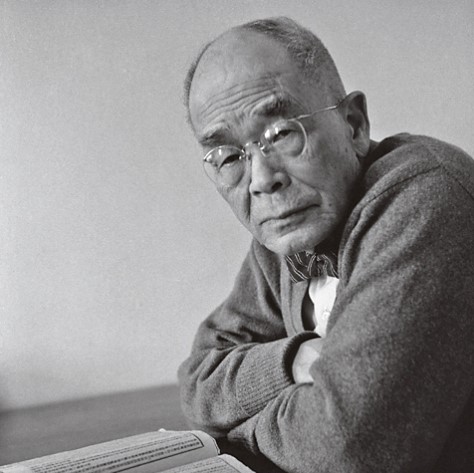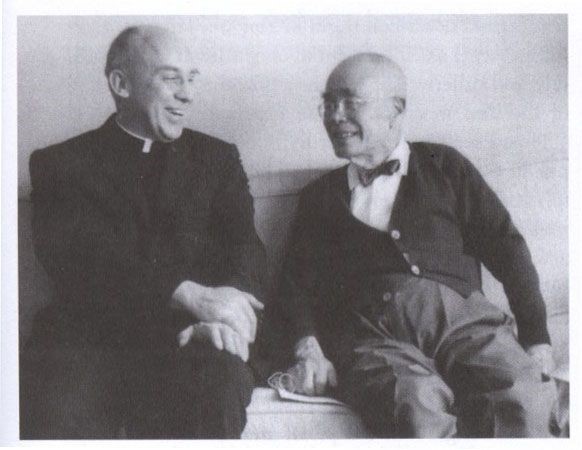FEATURES|THEMES|Philosophy and Buddhist Studies
Daisetsu Teitarō Suzuki: “Suzuki Zen”
It is no exaggeration to say that no single person has done more to bring Zen Buddhism to the West and to shape Western comprehension of this ancient Buddhist tradition than Japanese scholar Suzuki Daisetsu Teitarō (1870–1966), better known as D. T. Suzuki. For more than six decades, this prolific author worked tirelessly to promote and disseminate the knowledge and practice of Zen through a plethora of books and essays, as well as translations of Buddhist literature from Chinese, Japanese, and Sanskrit.
Both Suzuki’s influence in interpreting Zen for the West and his impact on modern popular culture have been colossal. Prominent 20th century intellectuals, such as Arnold Toynbee, Carl Gustav Jung, Thomas Merton, Aldous Huxley, Erich Fromm, and Karen Horney were fascinated by this modest yet charismatic person who truly believed that he was introducing the genuine expression of Zen.

D. T. Suzuki in Cambridge, Massachusetts, 1958.
Photo by Francis Haar. From popularbio.com
However, in parallel, Suzuki was in no way free from criticism. In an extensive series of academic articles and books published since the 1980s, he has been harshly censured for his depiction of Zen. For decades, Suzuki presented Zen to Western audiences who were unfamiliar with this Buddhist school and thus were not suitably knowledgeable to critically assess what he conveyed to them. Only recently have Western audiences been able to determine that the vision of Zen Buddhism that Suzuki proffered was a particular interpretation that was not only far from traditional Chinese Chan and classical Japanese Zen, but was also quite distinct from other expressions of Zen within the sweeping reforms and modernization of Zen that took place during the Meiji period (1868–1912).
This crushing criticism of D. T. Suzuki’s work is not widely known outside of academia. This unawareness, along with the enormous importance and continued popularity of Suzuki’s oeuvre are sufficient reason for us to take a moment—albeit a brief one—to consider this Japanese author and his interpretation of Zen. We will see how, despite well-reasoned criticisms, Suzuki’s contribution to the transmission of Zen Buddhism to the West merits him a significant place in the intellectual history of the 20th century.
“Suzuki Zen”
As Suzuki continued to teach Buddhist studies, his fame grew and it eventually became very clear that the Zen that Suzuki brought to the West was “a certain type of message.” In fact, a type of “Buddhist modernism,” which largely conflicted with orthodox Zen Buddhism prior to the Meiji era. It also became clear that Suzuki believed that his vision of Zen Buddhism was real and correct, and not driven ideologically. Since the 1990s, Suzuki has received a number of extremely severe criticisms across several fields. Modern scholarship—found primarily in the work of John R. McRae, Bernard Faure, Robert Sharf, and Victor Sōgen Hori, as well as other critics—unveiled a large gap between the classics of Chan and Japanese Zen and what would end up being called “Suzuki Zen,” (Suzuki 1964, 33) which subsequently became the target of rejection and deconstruction. Let us analyze these criticisms.
An initial series of accusations were related to Suzuki’s alleged ideological support of Japanese imperial militarism and staunch advocacy of the most chauvinistic features of Japanese culture. In 1997, the American author and Soto Zen priest Brian Daizen Victoria published the book Zen at War (Weatherhill), in which he accused the Japanese Zen Buddhist community of complicity with Japanese militarist imperialism from the time of the Meiji Restoration until after World War II. Victoria especially criticized Suzuki for his defense of bushido (“the Way of the Warrior”) and his dealings with the leaders of the Imperial Japanese Army during World War II. Kemmyo Taira Satō, a learned Shin priest, wrote an accurate defense of Suzuki, (Satō 2010) though it was published too late, as serious doubts had already been cast on Suzuki’s reputation.
The description Suzuki gives of Zen is not that of Chinese Chan from the golden age (Tang dynasty), but instead a peculiar vision that could be placed in a much broader modernist understanding of Buddhism that arose during the Meiji era. The latter was called “new Buddhism” (shin bukkyo), with which “Suzuki Zen” shares many traits: the accommodation of Buddhism to Western modernity, discarding irrational features of Buddhism, emphasizing logical features, and presenting Zen as a philosophy rather than a religion. In this vision, Zen is not a religion but a method that is free from any ties to specific religious systems. Some scholars started to identify “Suzuki Zen” in the 1930s as a type of Buddhist modernism, an outgrowth of Meiji Buddhism.
Suzuki said he was showing the “essence” of Zen, a “pristine” or “pure Zen,” from which he had discarded voluble and trivial features, such as its institutional, popular, hierarchical, ritualistic, and magical aspects. In a book published in 1991, Bernard Faure showed that far from being superficial or banal, these popular ceremonial and hierarchical features of Zen Buddhism—and even its magical or devotional aspects such as the worship of relics, deities, the mummification of teachers, the interpretation of dreams, and ritualism—form part of Chan and Zen as they have traditionally been practiced in China and Japan. Suzuki thus introduced a bare-bones Zen, abstracted from its historical-social context, evading its traditional reality. Iconoclastic rhetoric and the immediacy of Zen was a stance to attract power and sponsorship.
Suzuki claimed that “Zen is not a religion or philosophy, but the spirit of all religion and philosophy.” To Suzuki, Zen Buddhism was a mystical and universal experience that was present in all religions. Or, perhaps closer to the mark, “the spirit or essence that shores up all religions.” (1964, 33, 44) Suzuki Zen thus involves a type of Buddhist inclusivist perennialism supposedly superior to all formulations in other religions, including Christianity. To Suzuki, Zen was a unique phenomenon in the history of mysticism.
Furthermore, to Suzuki, the ultimate experience of Zen Buddhism is the same as the ultimate Christian experience, although the interpretations differ a posteriori. And as a method, Zen can lead to this Christian experience. Christians can practice Zen to improve their practice of Christianity. Suzuki’s interpretation in this area influenced the development of Christian Zen as a movement. However, it is obvious that Suzuki’s interpretation of Christian dogmas and symbols is far from orthodox and his knowledge of Christian theology was superficial and often wrong. Roger Corless showed in his investigations that Suzuki knew much less about Christian theology than one would expect. Surprisingly, Suzuki wrote comparative studies between Zen and Christianity, and had a great influence on authors such as Thomas Merton.

Thomas Merton and D. T. Suzuki in New York, 1964.
From bu.edu
The criticisms did not stop there. Others have censured Suzuki for lacking the necessary credentials to introduce and teach Zen as he did. They also charged that he lacked any Zen organization that supported his assertions. In readers’ imaginations, Suzuki appears as the completely enlightened Zen master (roshi). But he was always a secular scholar who trained outside of traditional monastic orders and never received a Dharma transmission. In particular, Robert Sharf criticized Suzuki for not having formal institutional approval, just like many others who popularized Zen in the West in the 20th century. This may seem unobjectionable, but as Sharf rightly points out: “We should be cautious before uncritically accepting their claim that Zen is some sort of nonsectarian spiritual gnosis.” (1994, 43)
Faure alleges that Suzuki’s interpretation of Zen Buddhism is “sectarian” and “partisan.” (1996, 54) Suzuki presents Zen from the Rinzai school as “the Zen” in and of itself, and makes few references to the Sōtō school, against which he revealed an obvious partiality and prejudice. Suzuki favored kōans and sudden enlightenment (satori) over seated meditation (zazen) and the understanding of enlightenment as a gradual process. To Suzuki, Dōgen Zen was too passive, quietist, gradualist, and intellectualist. This partiality was one of Suzuki’s greatest influences, as it would be how most casual readers in the West understood Zen until recent decades.
Suzuki was also denounced for emphasizing the interior personal experience and enlightenment (satori) over ritual, doctrines, practices, and the monastic life. Sharf explained that the emphasis on the interior experience has a political side by disqualifying those who lack it to evaluate the essence of Zen. (1995, 274)
In 1953, the Chinese scholar Hu Shih accused Suzuki of wrongly representing Zen, ignoring its history, and presenting a decontextualized Zen that totally disregards its historical aspects in favor of paying more attention to this ahistorical experience of enlightenment in an essentialist stance. Critics have also said that Suzuki conveyed a romanticized and idealized image of Zen Buddhism. There have even been accusations of “inverted Orientalism.” An image that is not purely academic, but is instead subjective, distorted, ideological, and proselytizing, showing Zen not only as superior to other Buddhist schools, but superior to all other religions, implying the superiority of the Japanese culture.
Conclusion
There have been authors who have defended Suzuki, mainly based on the nature of the Zen practice and experience vis-à-vis a critical academic vision. However, the majority of what has come to be known as “Suzuki Zen” is largely discredited. The big question that remains for many is therefore: how is it possible that Suzuki Zen became the primary way of understanding Zen in the West?
Faure responds to this: “Despite all of its rhetoric, the success of Suzuki’s work was not related to its literary or philosophical qualities; it was rather the result of a historical conjecture that prompted the emergence in the West of a positive modality of Orientalist discourse, which found a particularly suitable target in the Zen promoted by Suzuki.” (1996, 54) The vision of Zen that Suzuki inadvertently propounded has had an enormous influence in the West and, most likely, has contributed to disassociating Zen meditation from its Buddhist context. However, for many—including this author—Suzuki was the doorway that led to Zen and we owe our discovery of it to him.
Daniel Millet Gil holds a law degree from the Autonomous University of Barcelona, a master's degree in Buddhist studies (distinction) from the Center for Buddhist Studies of the University of Hong Kong, and a PhD in Buddhist studies from the Center for Buddhist Studies, University of Hong Kong. He is the recipient of the Tung Lin Kok Yuen Award for Excellence in Buddhist Studies (2018–19). He obtained his PhD in Buddhist studies with a comparative study between The Interior Castle de Santa Teresa of Avila and The Path of Purification of Buddhaghosa. His area of research is in comparative religion (in particular, comparative studies between Buddhism and Christianity), interfaith dialogue, and psychology of the self. Daniel Millet is a regular contributor and the managing editor of the Buddhistdoor en Español web platform. He has published numerous articles in both academic and informative journals that can be consulted at: https://hku-hk.academia.edu/DanielMillet
References
Faure, Bernard. 1991. The Rhetoric of Immediacy: A Cultural Critique of Chan/Zen Buddhism. Princeton: Princeton University Press.
Faure, Bernard. 1996. “Rise of Zen Orientalism,” in Faure, Bernard, Chan Insights and Oversights: An Epistemological Critique of the Chan Tradition, Princeton: Princeton University Press.
Satō, Kemmyō Taira. 2010. “Brian Victoria and the Question of Scholarship,” in The Eastern Buddhist, Vol. 41, No. 2, pp.139–66.
Sharf, Robert H. 1994. “Whose Zen? Zen Nationalism Revisited” in Heisig, James W. and Maraldo, John C. (eds). Rude Awakenings: Zen, the Kyoto School, and the Question of Nationalism. Honolulu: University of Hawai'i Press.
Sharf, Robert H. 1995. “Buddhist Modernism and the Rhetoric of Meditative Experience.” Numen 42(3): pp. 228–83.
Suzuki, D. T. 1964. An Introduction to Zen Buddhism. New York: Grove Press.
Works by D. T. Suzuki on Zen
Introduction to Zen Buddhism. 1934. Kyoto: Eastern Buddhist Society.
Manual of Zen Buddhism. 1935. Kyoto: Eastern Buddhist Society.
Zen and Japanese Culture. 1959. New York: Pantheon Books.
Other critiques of Suzuki
Corless, Roger. 1993. “In Search of a Context for the Merton-Suzuki Dialogue,” Merton Annual 6, 76–91.
Hori, Victor Sogen. 2005. “Introduction,” in Dumoulin, Heinrich (ed.), Zen Buddhism: A History. Volume 2: Japan, trans. by Heisig, James W.; Knitter, Paul, World Wisdom Books. pp. xiii–xxi.
Hu Shih. 1953. “Ch’an (Zen) Buddhism in China. Its History and Method,” Philosophy East and West, 3 (1). pp.3–24.
Victoria, Brian Daizen. 2006. Zen at War (2nd ed.), Lanham e.a.: Rowman & Littlefield Publishers.
Jackson, Carl T. 2010. “D. T. Suzuki, ‘Suzuki Zen,’ and the American Reception of Zen Buddhism,” in American Buddhism as a Way of Life, 2010, pp.39–56.
Sharf, Robert H. 1993. “The Zen of Japanese Nationalism,” History of Religions, 33 (1). pp.1–43.
See more
A Zen Life: The D.T.Suzuki Documentary Project
Related features from Buddhistdoor Global
Exploring Buddhism’s Tensions With Modernity: An Interview with Prof. David McMahan
The Modernization of Faith and Ideology: Victoria Montrose Discusses Japanese Buddhism’s 19th Century Transformation
What We’ve Gained and What We’ve Lost – Nothing and Everything: The Influence of Buddhism on the American Avant-Garde (1942 – 1962)














